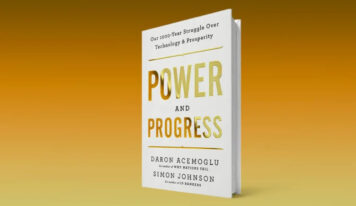How storytelling, or the art of gathering, creating, and telling stories, can mobilize teams, spread corporate culture, increase innovation and creativity, and, almost miraculously, make employees love what they do.
CENTRAL IDEAS:
1 – Storytelling, or the process of telling stories, is a powerful business tool. Successful organizations such as Microsoft, Nike, Motorola, 3M, and Berkshire Hathaway, among others, use this resource to set learning, improve their administrative practices, and disseminate the corporate culture.
2 – The effectiveness of storytelling, which since the 1990s has been regaining status as an indispensable tool in business management, comes from its simplicity (storytelling does not require great technical knowledge) and its durability (engaging stories are easily memorized and replicated);
3 – Through simple images, metaphors, characters, and descriptions of their epics, storytelling helps in the better understanding of the organization’s general objectives and in the creation of intermediate goals to achieve them.
4 – The very powerful capacity of storytelling to mobilize, inspire, and fix itself in the minds of collaborators is not surpassed by other expedients with these same purposes; proof of this is the corporate policy code, which virtually no one in the company reads, but that can be vividly translated by stories and experiences transmitted through storytelling.
5 – Telling stories, even personal ones, is a way to garner respect among employees and make leadership more fluid; circulating them among the various departments of an organization is also a way to carry best practices from one sector to another – something that visual presentations, reports, charts, and spreadsheets rarely achieve.
ABOUT THE AUTHOR:
American Paul Smith has become one of the great authorities on storytelling applied to business management. Besides “Lead with a story”, he has published “Sell with a story” and “10 stories great leaders tell”. With a degree in economics, Smith began his career at Arthur Andersen Consulting, before moving on to work for two decades at Procter & Gamble, where he held various leadership positions. Today he is a consultant to companies such as Google and HP.
THE BOOK:
Divided into 21 chapters, it also brings an interesting appendix with an onomastic index and practical models for the reader himself to create stories, “Lead with a story” was conceived in five major thematic groups – “envision success”, “create an environment for winning”, “energize the team”, “educate people” and “empower others”. The chapters have a common structure that is repeated very efficiently and serves as a metalanguage for the central theme – storytelling.
Each chapter always begins with a model corporate story that leads to a conclusion (or “moral” of the story) that tends to be easily memorized and replicated; at the end, there is a systematized summary and bibliography.
ENVISION SUCCESS
There are effective ways to involve the people being led in the overall objectives of the organization, and they include a well-told story (and therefore, as seen above, with great power to stick in the memory of the listeners).
One of the narratives that serve here as an example is the parable in which three workers are urged to tell a passerby what they are building.
One of them sticks to the measurements of the wall being built, but the “hero” of the story reveals that what they are building is a cathedral; the idea then is to share this grand vision with the team, creating an atmosphere of engagement.
Other highlights from the section: To achieve a lofty goal, you should consider creating intermediate and frequent goals, and along with them, establishing achievable commitments.
Using unambiguous parameters of what the concepts of success and failure are is very desirable, as this helps to disseminate a culture of accountability among those being led.
Storytelling is also an adequate instrument to facilitate change, something that is never well accepted by teams, even for psychoanalytical reasons – any change, as we know, involves risks or at least some kind of discomfort.
There are ways to double this resistance, creating, in the limit, an environment where change is mandatory – Paul Smith uses as an example the change made in the logic of an ATM that obliged the user to remove his card before being able to redeem the money, solving the problem: the forgetting of the card in the machine.

Making the visions of the leaders become also the visions of the followers, the true Grail of people management, is another task that can be provided by storytelling.
Using parables or metaphors to set a model success story and having a full understanding of what is being done or even demonstrated in a presentation (even those mundane, PowerPoint ones) is equally necessary.
The author further maintains in the section that model stories are being produced all the time, in the heat of the moment, in various parts of an organization, and they should not be overlooked.
On the contrary, they should be molded, formatted as engaging stories, and told to the employees. Good narratives are reports of creative customer service and stories from customers themselves expressed in forums, websites, and blogs.
There are minimum rules for the construction of a story that is likely to last. Context, action, and result (which the author calls CAR) are fundamental elements and must be presented in this order.

ENVIRONMENT FOR WINNING
Organizational culture can be lost if there is no effective way to disseminate it internally. Storytelling, by identifying exemplary stories of how the organization deals with its employees, responds to this demand.
On the other hand, the way the company acts to reprimand or rectify inappropriate or abusive behavior is just as important as telling such model stories; storytelling also has the power to set examples among employees, something that the corporate policy code, however liberal, does not have.
Therefore, to apply “for real” the code, it is essential to find real stories, with real employees, of how they experience or have experienced, in practice, the assumptions of the company’s corporate policy.
Nothing is more modeling for fixing organizational culture than stories of “values in action”. Knowing what the values and principles of a company are is important, but even more relevant is knowing – and spreading among employees – stories of how these values and principles are applied in day-to-day life.
Stories in which leaders use creativity to demonstrate integrity – the name used by the author in the act of expressing these values – are presented by Smith.
One such story is that of a former president of a global unit of P&G who, faced with difficulties in returning an expensive ticket to the Metropolitan Opera, in New York, given to him for his position in the company, finds a way to make his dog Gilda a benefactor of the “Met”.
Telling personal stories to peers and subordinates can be another excellent strategy for engaging teams. The assumption here is that by not telling passages of our lives to strangers – as would be the coworkers – they remain strangers. A tautological assumption, but okay.
Affirming diversity principles is equally important, but the stories that tend to gain more adherence in the corporation are not those told by those responsible for diversity areas; when it is leaders from other sectors who demonstrate the importance of diverse teams – and how this scenario helps the achievement of business – much better; even so, in markets or countries where the issues of equity and diversity are still recent, telling personal stories of overcoming black professionals who were victims of racism, for example, can be mobilizing.
The section also lends itself to telling that corporate policy manuals are a dead letter. Virtually no one in the company reads them. To spread the values contained therein, nothing like storytelling, nothing like an exemplary story – and again, for good (resulting in promotions) and for bad (reprimand or dismissal).
The behavior of employees overtime is determined exactly by this system of recognition and punishment, even if the reasons for this are completely unknown.
With storytelling, it is possible to reinforce the behavior that one wants to have in the company.

ENERGIZE THE TEAM
This section again shows the virtues of storytelling as a corporate leadership tool, with the emphasis now on the possibility of keeping teams focused, determined, engaged, and, in true defiance of the laws of probability, excited about their work.
Paul Smith’s suggestion here is to collect model stories inside or outside the professional environment, contemporary or not, and share them with the teams.
It is worth looking for examples in sports, such as that of Tanzanian John Stephen Akhwari, who finished the marathon at the Mexico City Olympics in 1968, even after a fall in the middle of the race that cost him a dislocated knee; the athlete would not have traveled so far to abandon what he had set out to do, that is the lesson; it is also worth rescuing stories that have been lost in the mists of time and take advantage of their didactics.
In the saga of the colonization of the American West, it is the difference between its protagonists that counts: there were the pioneers who explored these destinations, staying a short time in one stop and already leaving for the next; and those who effectively colonized them.
Stories of persistence in the viability of a project or product, despite adverse prognoses and initial numbers, also help to engage teams. A model example of the topic is P&G’s launch of the Pringles potato in the late 1960s.
The potato experienced six years of steep declines in sales in the United States starting in 1975, yet its production and marketing were not interrupted. Such stories are not uncommon, argues the author, and are likely to have happened in the very company where the engagement of the followers is desired.
Myths and stories worthy of children’s literature anthologies can be useful in the relationship with the teams. The author uses the myth of the giant who frightened a village with only his voice; finally challenged by a woman, he ends up revealing himself to be a ridiculous being, the size of a thimble. The moral of this myth applied to day-to-day corporate life: the fear of failure or error should not be a hindrance to the start of any project or initiative.
Finally, if it is so often difficult to make the employee have positive feelings about his or her routine, it is worth looking for “shortcuts”.
By getting to know the personal stories of the customers, and thus trying to create empathy between customers and employees; one should also try to eliminate the, shall we say, banana peels from the day to day – and to underline the effectiveness of storytelling in achieving this, the author uses the parable of a female commanding officer who sneaks out of the umpteenth meeting she took part in, once again very boring. The unusual detail: the subordinate was the daughter of the boss who conducted the meeting.

EDUCATE PEOPLE
A great way to present the team’s situations in which decision-making can lead to very different consequences is what Paul Smith calls “Lead with a story” “two road stories” – something that could be loosely translated as “stories at the crossroads”.
With them, it is possible to show clear cases of successful and unsuccessful outcomes. If these “crossroads stories” make use of real people and real challenges, so much the better; in the absence of them, the author still proposes ways to create them.
Failure has a didactic character. Thus, stories of failed journeys should not be ignored. The suggestion here is that leaders report their cases, not only for collective mobilization but to help humanize leadership.
A powerful tool for engagement is feedback, but given the almost proverbial difficulties that people have to receive it, the author presents a strategy for this to happen without arousing great upset.
The feedback should start with a positive aspect of the leader’s performance, then seek confirmation that there is a problem to be addressed, and also make a clear and concrete offer of help, among other steps.
Even so, the recipients of this feedback can remain completely obtuse and interdicted, refusing to recognize problems in their conduct and performance.
Again, the use of storytelling devices is widely recommended, and the author does not shy away from mobilizing a Biblical parable here, the story of King David and Bathsheba, which teaches that:
(a) the haughtiness of not admitting that one is erring is common and disregards classes and ranks;
(b) even sovereigns can be convinced, in the end, that they make crystal clear and eloquent mistakes.
Although such a command is trivial and widespread, asking someone to see “outside the box” is not usually accompanied by an instruction manual; to account for this, Paul Smith suggests that leaders draw on a piece of paper two games in which it is necessary to connect nine dots without taking the pen off the paper or changing the direction of the dotted line – it will then be mandatory to use a larger space on the paper, in a literal demonstration of this “outside the box” thinking. This is the way the author chooses to introduce the theme of solving everyday problems in the corporate environment.
Heterodox solutions include, for example, anticipating problems, and avoiding them; using model examples in science, even more than in the corporate narrative can stimulate teams to seek these solutions; and if the problems are complicated and seemingly insurmountable, it is worth reducing them and dividing them into small segments, in a movement similar to that taught by the philosopher René Descartes in his search for the famous clear and distinct ideas (the illuminist’s method enters here as a commentator’s tip; it is not in Smith).
Finally, it is not always easy to identify problems. When it comes to a customer who is dissatisfied because of inferior service, you have to compensate that customer in some way – and at the same time seek a solution to the cause of that dissatisfaction, which is a symptom of a dangerous internal dysfunction.
Consumers are, by the way, a source of diagnoses of problems. Smith proposes that leaders and their teams regularly visit them and listen to them.
For the author, the reports heard there has greater mobilizing power than the cold numbers and data from internal surveys and reports.

EMPOWER OTHERS
Counterintuitive decisions that may not conform to the organizational canon are sometimes the most appropriate.
So it is worth telling stories that make explicit the use of “instincts” in the production of these decisions, in the word used by Smith. The implicit lesson: using one’s judgment is often necessary, even if at odds with management.
To encourage creativity and innovation in those you command, be armed with stories that demonstrate that the progress society has achieved in many areas comes from a curious and even irreverent attitude.
Someone in those moments certainly made use of the “what if” formulation – “what if instead of having done it this way, we did it this way” etc. Asking this simple and powerful question is just as powerful as asking “why?”
It is also important to keep in mind that innovation is not exclusively in the creation of a new good, product, or service, but sometimes in the redesign of the task that will ultimately generate that same good/product/service. It may have appeared a face ago, but now it can bring fewer costs and more benefits to its creators.
Finally, involving sectors of the company with the sales area, and doing it through storytelling, is a winning strategy to achieve better performance. The example chosen by Smith again comes from P&G and shows how the purchasing sector of a unit of the transnational on the West Coast of the United States began to negotiate better with suppliers after making contact (i.e.: listening to stories) with leaders of the sales areas.

FACTSHEET:
Title: Lead with a Story – A guide to crafting business narratives that captivate, convince and inspire
Author: Paul Smith
First Edition: HarperCollins (Amacom Books imprint)
Images: Freepik
Review: Paulo Vieira
![[Experience Club] US [Experience Club] US](https://experienceclubus.com/wp-content/uploads/2021/03/laksdh.png)










![[Experience Club] US [Experience Club] US](https://experienceclubus.com/wp-content/uploads/2021/03/logos_EXP_US-3.png)







